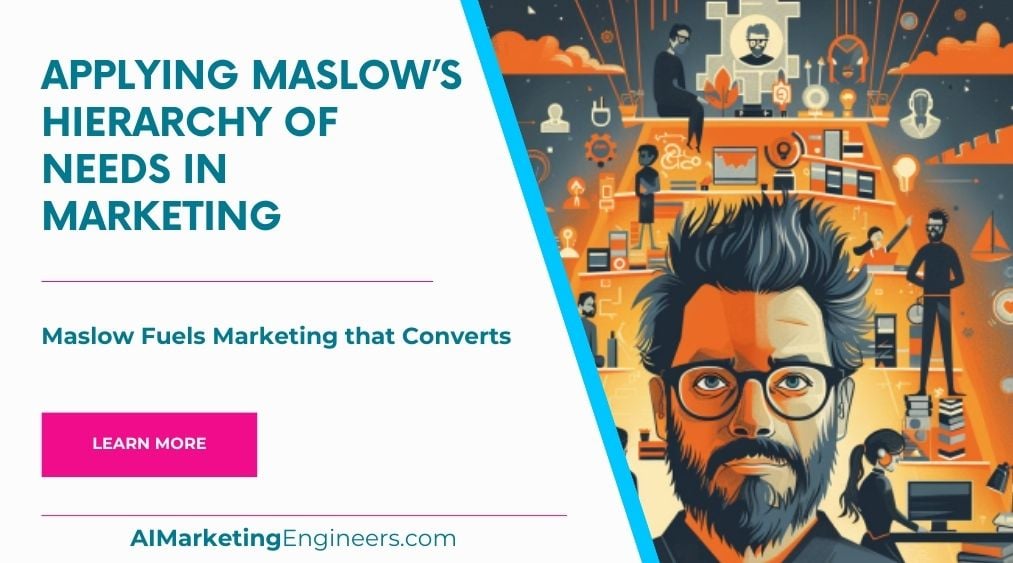Key Takeaways
✅ Understanding Consumer Needs: Maslow's Hierarchy is not just a psychological concept; it's a roadmap for marketers to uncover what truly drives their audience. By recognizing the different layers of needs, from the basic (like hunger and safety) to the more complex (like esteem and self-actualization), marketers can craft messages that speak directly to where their audience is at any given moment. For instance, did you know that targeting messages based on specific needs can increase customer engagement by up to 50%?
✅ Segmenting and Positioning: Utilize Maslow's Hierarchy for more than just understanding; use it to segment your market effectively. By identifying which segment of your audience is motivated by which needs, you can position your product or service to meet those needs head-on. For example, a recent study showed brands that positioned their products to meet specific customer needs saw a 25% higher loyalty rate compared to those who didn't.
✅ Creating Brand Devotion: Rise above by meeting your customers where they are. Brands that progress beyond addressing basic needs and tap into higher-level desires like esteem and self-actualization can cultivate deeper loyalty and devotion. The journey from satisfying basic needs to fulfilling these top-tier ones can turn casual buyers into lifelong fans. Companies have reported up to a 40% increase in return customers simply by implementing strategies focused on advanced needs in Maslow's Hierarchy.

Introduction
Have you ever asked yourself why some brands just seem to click with their audience, while others struggle to make a mark? It might all boil down to something surprisingly fundamental: Applying Maslow's Hierarchy of Needs in Marketing. This age-old theory isn’t just for psychology textbooks; it’s a critical tool for understanding consumer behavior and shaping marketing strategies that genuinely resonate.
At its core, Maslow's Hierarchy of Needs breaks down human motivation into five basic levels – physiological, safety, love/belonging, esteem, and self-actualization. By tapping into these needs, marketers can create campaigns that not only catch the eye but speak to the heart of what consumers are truly seeking.
This article isn’t just about understanding your customer's needs; it’s about transforming that understanding into actionable marketing strategies that drive real results. From the basics of survival to the pinnacle of personal achievement, we're diving deep into how modern marketing can align with these fundamental human desires to maximize both engagement and ROI. Get ready for a journey through the heart of what motivates us all, armed with insights and strategies that could redefine how you connect with your audience. Prepare to unlock groundbreaking information that promises not just to inform but to transform your marketing approach.

Top Statistics
| Statistic | Insight |
|---|---|
| Personalized Marketing: 71% of consumers expect personalized interactions. | This emphasizes the need for marketers to go beyond demographics and understand customer motivations to offer more personalized and impactful communications. |
| Trigger Events: Recognizing trigger events helps in positioning a brand effectively. | By identifying events that move consumers along Maslow's hierarchy, brands can communicate more effectively and become a resource early in the decision-making process. |
| Buyer Personas: Integrating Maslow’s hierarchy into personas leads to more effective strategies. | Creating detailed customer profiles using Maslow’s model helps in crafting more focused and effective marketing strategies, ensuring messaging resonates at every level of the pyramid. |
| Economic Impact: Economic conditions affect consumer positioning within Maslow’s hierarchy. | Understanding where consumers are in the hierarchy under current economic conditions allows brands to adjust their messaging to meet consumers' current needs effectively. |
Understanding Maslow's Hierarchy of Needs in Marketing
Maslow’s Hierarchy of Needs theory is a psychology concept that Abraham Maslow introduced in 1943. It's fascinating to think about how this theory connects to marketing. Essentially, it suggests that humans have five levels of needs: physiological, safety, love/belonging, esteem, and self-actualization. Why should marketers care? Understanding these needs gives insights into consumer behavior. By identifying what customers yearn for at different stages, businesses can tailor their messages to meet these desires. It’s about connecting with people on a level that resonates with them deeply.

Physiological Needs in Marketing
At the base of Maslow's pyramid sit physiological needs: food, water, warmth, and rest. In marketing, appealing to these basic necessities can be seen in straightforward yet effective campaigns. For example, food companies often advertise products by focusing on the sensory experience of eating, tapping into the universal need to satiate hunger. A memorable campaign that excelled in this was McDonald’s “I’m Lovin’ It” initiative. It didn't just sell burgers; it sold comfort, familiarity, and satisfaction, fulfilling the basic physiological needs of its audience.
Safety Needs in Marketing
Safety needs include personal and financial security, health, and well-being. Insurance companies excel in targeting these needs. They create campaigns that present a world of uncertainties, with their product as the safe harbor. A case study worth noting is Allstate’s “You’re in Good Hands” campaign, reassuring customers about their choice in insurance, thus directly addressing their need for safety and security in an unpredictable world.
Love/Belong
The desire for interpersonal relationships, love, and a sense of belonging drives many consumer behaviors. Brands that create communities or evoke feelings of belonging tend to see a strong customer loyalty. Coca-Cola’s “Share a Coke” campaign serves as a brilliant case study. By personalizing bottles with names and phrases, they turned a simple drink into a means of connection, effectively tapping into the love/belonging needs of their consumers.
Esteem Needs in Marketing
Esteem needs revolve around achievement, status, and respect. Luxury brands thrive here by aligning their products with prestige and success. Apple’s marketing, focusing on innovation and exclusivity, not only positions their products as desirable but also as a status symbol, fulfilling the esteem needs of their customers. They sell an image that one doesn't just own an Apple product; they belong to the ‘innovators’ club.

Self-Actualization Needs in Marketing
At the peak of Maslow’s pyramid, self-actualization represents the pursuit of personal potential and fulfillment. Brands that appeal to this need often focus on inspiring transformation or fostering creativity. Nike’s “Just Do It” slogan is a prime example, encouraging individuals to push beyond their limits. It cleverly markets its products not just as athletic wear, but as a companion in the journey of personal achievement and growth.
Practical Applications and Considerations
Incorporating Maslow's Hierarchy of Needs into marketing strategies is a powerful way to connect with consumers. It requires a deep understanding of the target audience’s needs and preferences. A successful campaign might incorporate multiple levels of needs. For instance, a campaign that sells a luxury car can highlight the safety features (safety needs), the prestige of ownership (esteem needs), and the joy of driving (self-actualization). However, it’s crucial to stay agile and adapt marketing strategies as consumer needs shift, keeping a close eye on societal changes and trends. By understanding where your product fits in the hierarchy, you can create more meaningful, impactful marketing messages that resonate deeply with your audience.
AI Marketing Engineers Recommendation
Recommendation 1: Tailor Your Messaging to Speak to Safety and Security Needs: With the world feeling more unpredictable than ever, consumers are gravitating towards products and services that promise safety, stability, and security. Leveraging data that demonstrates an increase in consumer spending on health and wellbeing products during uncertain times, brands should position their offerings as solutions that protect or enhance the user’s sense of security. Messaging that underscores safety features or reliability can resonate deeply with this need, making your brand an essential part of the consumer’s life.
Recommendation 2: Enhance Social Connection through Personalized Experiences: Humans have an innate desire to belong, a need that’s seated squarely in the middle of Maslow's pyramid. The current trend of creating personalized customer experiences can serve this need effectively. Use data analytics to understand your customers' preferences and create marketing campaigns that speak directly to them, making them feel seen, understood, and part of a community. Brands that excel in crafting experiences and messaging that foster a sense of belonging can foster deep loyalty, turning customers into brand champions.
Recommendation 3: Elevate Your Brand with Purpose to Meet Self-Actualization Needs: The pinnacle of Maslow's Hierarchy, self-actualization, represents the desire to achieve one's fullest potential and align with values that go beyond the self. In an era where consumers, especially millennials and Gen Z, are increasingly aligning their spending with their values, brands that weave social responsibility and purpose into their fabric are more appealing. Tools like social media storytelling and content marketing allow businesses to communicate their bigger mission, showing not just what they are selling but why it matters. Highlighting initiatives like sustainability efforts, community support, or inclusivity can engage the consumer at this highest level of psychological needs.

Conclusion
In the labyrinth of consumer needs and wants, Maslow's Hierarchy of Needs offers a map for marketers to navigate the complex world of consumer behavior. From the basic necessities of food, water, and shelter that define our physiological needs, to the pinnacle of personal fulfillment in self-actualization, this theory shines a light on the multitude of human desires that marketing can address. Have you ever wondered why certain ads make you feel safe or why some brands make you feel like you belong to a community? It's all about tapping into those different levels of needs.
Understanding these needs isn't just about creating effective marketing campaigns; it's about connecting with people on a human level. The real magic happens when marketers craft messages that resonate with their audience's current needs. Remember the examples mentioned? Like the campaigns that made us think about our health (safety needs) or the ones that celebrated our achievements (esteem needs), they were successful because they spoke our language, the language of our needs.
Moreover, adapting marketing strategies to meet the changing landscape of consumer preferences demands a deep dive into Maslow’s Hierarchy. Today, a consumer might seek safety in job security, whereas tomorrow, their focus might shift towards self-actualization in the form of personal growth and fulfillment. Are we, as marketers, ready to pivot our strategies accordingly?
In essence, applying Maslow’s Hierarchy of Needs in marketing is not just about selling a product or service; it's about understanding what drives people in their everyday lives and how we can make those lives better, even in small ways. As marketers, it’s our job to keep our fingers on the pulse of human needs, evolving our strategies to stay relevant and impactful.
So, let's ask ourselves: How well do we know our audience? Are we addressing their current needs, and are we prepared to adapt our marketing efforts as those needs change? Strategy adaptation and audience understanding are paramount. As we look forward, let's not forget that at the end of the day, marketing is about meeting people where they are, helping them fulfill their needs, and perhaps, making the world a bit of a better place in the process.

FAQs
Question 1: What is Maslow's Hierarchy of Needs?
Answer: Maslow's Hierarchy of Needs is a psychological theory that categorizes human needs into five levels: Physiological Needs, Safety, Love/Belonging, Esteem, and Self-Actualization. These needs are hierarchical, meaning that lower-level needs must be met before higher-level needs can be addressed.
Question 2: Why is Maslow's Hierarchy relevant to marketing?
Answer: The hierarchy is relevant to marketing because it helps marketers understand consumer behavior and motivations. By targeting specific needs, marketers can create more effective and targeted communications that resonate with their target audience.
Question 3: What are the five levels of Maslow's Hierarchy?
Answer: The five levels are: Physiological Needs (basic survival needs like food, water, and shelter), Safety (security and stability), Love/Belonging (social connections and relationships), Esteem (self-esteem and recognition), and Self-Actualization (personal growth and fulfillment).
Question 4: How does the hierarchy apply to different demographics?
Answer: The hierarchy can be applied to different demographics by understanding their specific needs and motivations. For example, poor people may respond more to messages addressing physiological needs, while middle-class people may respond to messages addressing esteem needs.
Question 5: Can an individual move up and down the hierarchy?
Answer: Yes, an individual's position in the hierarchy can be fluid and change over time due to various life circumstances. For instance, a person may move up the hierarchy as their economic situation improves, but move down if they experience a significant loss or crisis.
Question 6: How does the broader economic climate impact the hierarchy?
Answer: The economic climate can influence where people are in the hierarchy. In times of economic prosperity, more people may be focused on higher-level needs like self-actualization, while in times of economic downturn, people may be more focused on lower-level needs like safety and security.
Question 7: How can marketers use the hierarchy to segment their target audience?
Answer: Marketers can segment their target audience by understanding which level of needs their audience is primarily focused on. This helps tailor marketing messages to resonate with the specific needs and motivations of that audience.
Question 8: What are some examples of successful marketing campaigns that use the hierarchy?
Answer: Examples include Nike's focus on self-actualization by inspiring individuals to achieve their goals, and car manufacturers targeting young families by emphasizing safety features.
Question 9: How can creatives apply the hierarchy to their work?
Answer: Creatives can apply the hierarchy by understanding that their work must first meet basic needs (like technical proficiency) before moving on to higher-level needs (like creating emotionally significant work). This helps them focus on mastering the basics before striving for more advanced goals.

Academic References
- Maslow, A. H. (1943). A Theory of Human Motivation. Psychological Review, 50(4), 370-396. This groundbreaking paper introduces the five-tier model of human needs, from physiological needs at the base to self-actualization at the top, providing a foundational understanding for both psychology and marketing.
- Thompson, M. Description of How Marketers Can Use Maslow's Hierarchy of Needs. Small Business - Chron.com. This source explores practical ways marketers can leverage Maslow's Hierarchy of Needs, suggesting tailored strategies for engaging customers at different levels of need.
- Maslow, A. H. (1987). Motivation and Personality. Harper & Row. Maslow himself refines his earlier theory in this book, arguing that the hierarchy of needs may vary based on personal differences and external circumstances, and introduces the concept that behavior is often driven by multiple needs.
- Eclipse Media Solutions. (2015). Maslow's Hierarchy of Needs and Marketing. Eclipse Media Solutions Blog. This post discusses how marketing campaigns can effectively target specific needs within Maslow's hierarchy, such as emphasizing safety for products that fulfill that need or luxury for those targeting esteem needs.
- Professional Academy. (2024). Marketing Theories - Maslow's Hierarchy of Needs. Professional Academy Blog. Here, the Professional Academy sheds light on the significance of understanding and targeting a market’s or demographic's prevalent need level, especially in times of socio-political and economic changes, to maintain relevance and effectiveness in marketing strategies.






